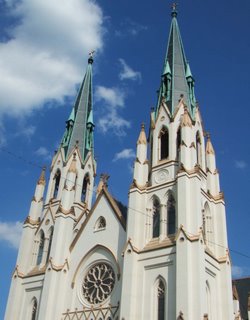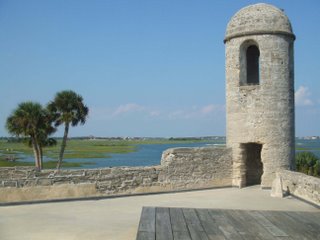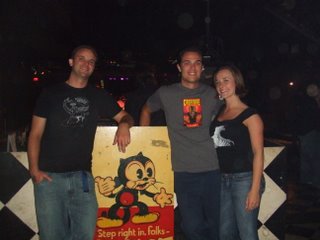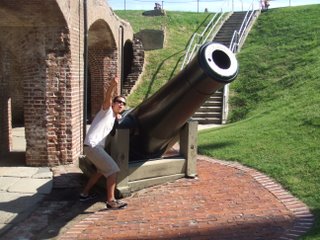 I’m not really sure when the bulk of the downtown area was constructed, but from a city planning point of view, it doesn’t really fit in with the expansive historical district, which if I was in charge, it would.
I’m not really sure when the bulk of the downtown area was constructed, but from a city planning point of view, it doesn’t really fit in with the expansive historical district, which if I was in charge, it would. The timing of the Savannah visit was slightly tricky because The Savannah Jazz Festival was taking place in the middle of the city, and nearly every hotel was booked solid. Lea and I were forced to stay slightly out of the city center, which ended up being fine because the drive into town was a straight shot down a prominent boulevard and provided the opportunity to see areas that would have otherwise gone undetected. Unfortunately, we missed the bulk of the Jazz Festival, but it felt justified because there is just too much to see, and spending all day at the crowded Forsyth Park would have been a waste of our limited, and precious, time. Instead, time was well spent viewing the countless historical sites, walking the shady avenues, and just taking in the southern way of life.
Savannah is definitely a walking city. However, if you’re not into walking, it is a carriage city as well, because there are things to see on every street and corner. You can get from one beautiful plaza to the next without much effort, and in some cases the historical houses of note, such as the Mercer-Williams House, a.k.a. “the house from The Midnight In The Garden of Good and Evil,” and The Owens-Thomas House, are a mere stones-throw from one another.
 The Owens-Thomas House is one of the most accurately restored houses in the city that can be toured inside and out. It is a very worthwhile activity to tour a house, because not only do you get to see the architecture and interior design of the house, but the tour guides also provide a very thorough history of the city while leading the tour. Our tour guide was a fast talking loon, but she did give a good tour and was filled with profuse amounts of random information. The Mercer-Williams House, perhaps the most well known in Savannah due to the book and film “Midnight in The Garden of Good and Evil,” was unfortunately closed when we were there, but it was nevertheless compelling to see.
The Owens-Thomas House is one of the most accurately restored houses in the city that can be toured inside and out. It is a very worthwhile activity to tour a house, because not only do you get to see the architecture and interior design of the house, but the tour guides also provide a very thorough history of the city while leading the tour. Our tour guide was a fast talking loon, but she did give a good tour and was filled with profuse amounts of random information. The Mercer-Williams House, perhaps the most well known in Savannah due to the book and film “Midnight in The Garden of Good and Evil,” was unfortunately closed when we were there, but it was nevertheless compelling to see. A place that does require a drive outside of Savannah, but is well worth the extra time, is the Fort Pulaski National Monument. The Fort, which is named after the Revolutionary War hero Count Cashmir Pulaski, is a remarkably well preserved, restored, and staffed Civil War-era stronghold. The Fort has underground shelters for its magazines and gunpowder, multiple moats, drawbridges, brick spiral staircases, a dungeon, broad ramparts, portcullises, cannons pointing in all direction, and a baseball field.
 Unlike Fort Sumter, which was remodeled during each World War, Pulaski stands in the same fashion as it did in the late 1800s, with the exception of its rebuilt south-east facing wall. The Fort, which took nearly thirty years to be created from the original idea to its final armament, was the site of the first significant use of rifle-barreled cannons. The new developments in artillery, used in the Battle of Fort Pulaski, rendered the Fort, and other such brick-wall fortifications, practically obsolete. Even without such significant history, the Fort would be an amazing place to visit due to its picturesque location on the South Channel, and the kelly-green fields and swampland surrounding the brick red building. Now that’s good knowledge.
Unlike Fort Sumter, which was remodeled during each World War, Pulaski stands in the same fashion as it did in the late 1800s, with the exception of its rebuilt south-east facing wall. The Fort, which took nearly thirty years to be created from the original idea to its final armament, was the site of the first significant use of rifle-barreled cannons. The new developments in artillery, used in the Battle of Fort Pulaski, rendered the Fort, and other such brick-wall fortifications, practically obsolete. Even without such significant history, the Fort would be an amazing place to visit due to its picturesque location on the South Channel, and the kelly-green fields and swampland surrounding the brick red building. Now that’s good knowledge.The last night in Savannah, Lea and I went to the Savannah Bistro for some Savannah style cooking. Lea had a whole flounder with apricot marmalade, and I had some amazing pan-fried tilapia with battered and deep-fried crab & onion crisps on top accompanied by garlic mashed potatoes. Mine was amazing, the whole fried flounder was slightly intimidating.
Side note: In the South anything can be deep-fried. While in Florida I heard about deep-fried Coca-Cola Classic. I was unreservedly intrigued and asked a guy who looked about the right weight of someone who would indulge in such an innovation to explain it. As it was described to me: Deep-fried Coca-Cola is a batter similar to funnel cake, but instead of water, Coca-Cola is used in the mixture. The batter is deep-fried until crisp, sprinkled with powdered sugar, and topped with Coca-Cola syrup. You can have it with ice cream, making the end result something close to a Cola float. Wow! Genius! Well, I didn’t have any, but it sounded interesting…
On the way south to Florida, a stop at “The GA Pig” was necessary because I think I somehow had managed to go almost two days without eating bar be que pork, and I needed my fix. The Georgia Pig is what a rural southern bar be que joint should look like. When I dream of pulled pork at night, I dream of it oozing from a building like the one The Georgia Pig is in.
 It is stationed in a log cabin right off the highway under a shady grove of trees with group of wooden tables scattered about. It reminded me of the kind of place that I always imagined Paul Bunyan, Davey Crocket, or Abraham Lincoln growing up in. Inside are large wooden tables with all the necessary condiments and accessories in the center, including the essential bar be que sauce squirting bottles, hot sauce sidekick, and large rolls of paper towels. All these items are to be used to the point of excess. While ordering, you must throw in some cups of beans and slaw, at 99 cents a pop, and you’re a sleeping bag away from making that log cabin your home. It is such a loveable, and intriguing place that there is a sign on the front door that states, “No photography allowed inside,” or something like that. In short, if you find yourself driving around in south-east Georgia and are in need of some bar be que, don’ think, just do, and stop at The GA Pig.
It is stationed in a log cabin right off the highway under a shady grove of trees with group of wooden tables scattered about. It reminded me of the kind of place that I always imagined Paul Bunyan, Davey Crocket, or Abraham Lincoln growing up in. Inside are large wooden tables with all the necessary condiments and accessories in the center, including the essential bar be que sauce squirting bottles, hot sauce sidekick, and large rolls of paper towels. All these items are to be used to the point of excess. While ordering, you must throw in some cups of beans and slaw, at 99 cents a pop, and you’re a sleeping bag away from making that log cabin your home. It is such a loveable, and intriguing place that there is a sign on the front door that states, “No photography allowed inside,” or something like that. In short, if you find yourself driving around in south-east Georgia and are in need of some bar be que, don’ think, just do, and stop at The GA Pig.Jacksonville, Fl. is about as close a modern city can get to being a ghost town. On a warm, sunny, Sunday afternoon, there was hardly a soul out in the downtown streets or at the shops, restaurants, and bars of Jacksonville Landing. I actually felt bad for the people working at the shops that were intended to be tourist stops, because they literally had nothing to do. The busiest place on Jacksonville’s riverfront, which was a very pleasant place, was the ice cream shop, where the line moved slower than growing grass. I would cry if I were forced to move to Jacksonville.
St. Augustine, on the other hand, has it going on, with really nice beaches, Spanish-colonial downtown, and numerous tourist friendly locations in close proximity. The two days I spent in St. Augustine, I lounged in eighty-five degree weather and seventy degree water and I really can’t complain, because although small, St. Augustine has character to spare. For a town with as much history as St. Augustine possesses, the people who live in the city claim that there really isn’t much to do. I personally found plenty to do, but I could definitely see their point. The town had become a tourist trap of the worst kind, where every old building is a pay to see attraction, and areas of the very pleasant downtown were gated off in an amusement park fashion. The whole idea of St. Augustine being a Spanish and Pirate history epicenter was slightly ruined by the over commercialization of interesting places. The best, or perhaps I should say worst, example is the infamous, “Fountain of Youth.”

Oh eeyeah, I just drank from the Fountain of Youth and feel young again. That’s the way I had hoped I would feel, but after choking down the metallic tasting water I felt more like spitting it back up. The mildly entertaining amusement park that is the Fountain of Youth is barely, just barely, worth the $6.50 admission price. The property consists of pathways, peacocks, a severely out-of-date planetarium, and a shack with plaster conquistadors and Indians standing around the supposed fountain itself. It’s essentially a hole in the ground, where water is naturally filtered by the underground caves and comes out relatively pure. The legendary conquistador, Don Juan Ponce de Leon went searching for the underground spring in 1513 and it ended up being the reason that Florida fell under Spanish rule. It’s an insignificant, but awkwardly momentous, landmark in American history.
 Apparently, Indians in the Caribbean, who were trying to convince the Spanish to leave their island for something better, told the myth of the Fountain of Youth. Ponce de Leon, never one to miss an opportunity to impress the King of Spain, gullibly left the tropical islands and landed in St. Augustine. “Wow,” I thought, “How could something so interesting, be so horribly presented to the public.” It was sad. On the flip side, the Castillo de San Marcos, a fort built in 1695 and run by the National Park System, was spectacular to visit. With knowledgeable staff, and no cost to me to get in, the Castillo is a shining example of why historically significant places in American history should be run by the Nation Park System.
Apparently, Indians in the Caribbean, who were trying to convince the Spanish to leave their island for something better, told the myth of the Fountain of Youth. Ponce de Leon, never one to miss an opportunity to impress the King of Spain, gullibly left the tropical islands and landed in St. Augustine. “Wow,” I thought, “How could something so interesting, be so horribly presented to the public.” It was sad. On the flip side, the Castillo de San Marcos, a fort built in 1695 and run by the National Park System, was spectacular to visit. With knowledgeable staff, and no cost to me to get in, the Castillo is a shining example of why historically significant places in American history should be run by the Nation Park System. Next stops: Atlanta, Nashville & Memphis, oh my!





